External links
![]() Media related to Bofors 40 mm gun at Wikimedia Commons
Media related to Bofors 40 mm gun at Wikimedia Commons
Bofors 40 mm gun is a name or designation given to models of 40 mm calibre automatic anti-aircraft guns designed and developed by the Swedish company Bofors:
![]() Media related to Bofors 40 mm gun at Wikimedia Commons
Media related to Bofors 40 mm gun at Wikimedia Commons

An anti-aircraft vehicle, also known as a self-propelled anti-aircraft gun (SPAAG) or self-propelled air defense system (SPAD), is a mobile vehicle with a dedicated anti-aircraft capability.
AB Bofors is a former Swedish arms manufacturer which today is part of the British arms manufacturer BAE Systems. The name has been associated with the iron industry and artillery manufacturing for more than 350 years.

Anti-aircraft warfare, counter-air, anti-air, AA guns, layered air defence or air defence forces is the battlespace response to aerial warfare, defined by NATO as "all measures designed to nullify or reduce the effectiveness of hostile air action". It includes surface based, subsurface, and air-based weapon systems, associated sensor systems, command and control arrangements, and passive measures. It may be used to protect naval, ground, and air forces in any location. However, for most countries, the main effort has tended to be homeland defence. NATO refers to airborne air defence as counter-air and naval air defence as anti-aircraft warfare. Missile defence is an extension of air defence, as are initiatives to adapt air defence to the task of intercepting any projectile in flight.
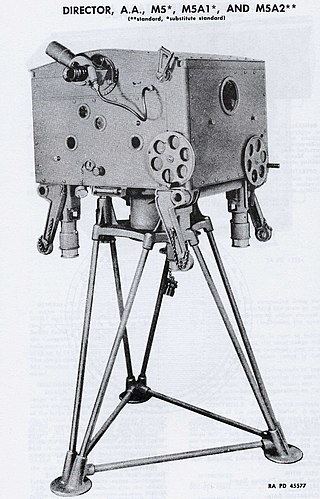
The Kerrison Predictor was one of the first fully automated anti-aircraft fire-control systems. It was used to automate the aiming of the British Army's Bofors 40 mm guns and provide accurate lead calculations through simple inputs on three main handwheels.

The Bofors 40 mm Automatic Gun L/60 is an anti-aircraft autocannon, designed in the 1930s by the Swedish arms manufacturer AB Bofors. The gun was designed as an intermediate anti-aircraft gun, filling the gap between fast firing close-range small calibre anti-aircraft guns and slower firing long-range high calibre anti-aircraft guns, a role which previously was filled by older outdated guns. The Bofors 40 mm L/60 was for its time perfectly suited for this role and outperformed competing designs in the years leading up to World War II in both effectiveness and reliability.

The Bofors 37 mm anti-tank gun was an anti-tank gun designed by Swedish manufacturer Bofors in the early 1930s originally for Swedish use. It was exported to several countries during the 1930s of which several bought licences to produce it themselves. The gun was used in several conflicts but most of its fame comes from its use in the Spanish Civil War and the Winter War where it was used very successfully against light tanks and armored cars among other targets. Beyond its use as an infantry gun it was also used as the main armament in several armored cars and tanks such as the Dutch M39 Pantserwagen and the Polish 7TP to name a few. As the armor of tanks was increased during World War II the gun very quickly became obsolete as an anti-tank gun but was still used effectively as an infantry support gun for the entirety of the war, and well into the Cold War. This was due to its high fire rate, great mobility and effective high explosive shells.
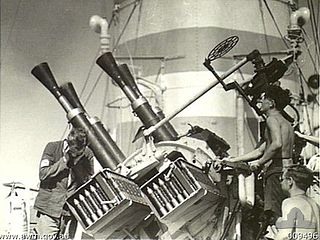
The 2-pounder gun, officially the QF 2-pounder and universally known as the pom-pom, was a 40 mm (1.6 in) British autocannon, used as an anti-aircraft gun by the Royal Navy. The name came from the sound that the original models make when firing. This QF 2-pounder was not the same gun as the Ordnance QF 2-pounder, used by the British Army as an anti-tank gun and a tank gun, although they both fired 2 lb (0.91 kg), 40 mm (1.6 in) projectiles.

The Type 96 25 mm gun was an automatic cannon used by the Imperial Japanese Navy during World War II. A locally-built variant of the French Hotchkiss 25 mm anti-aircraft gun, it was designed as a dual-purpose weapon for use against armored vehicles and aircraft, but was primarily used as an anti-aircraft gun in fixed mounts with one to three guns.
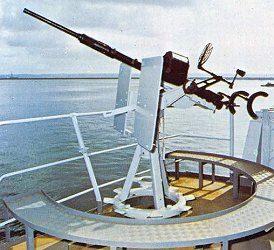
The Oerlikon 20 mm cannon is a series of autocannons based on an original German Becker Type M2 20 mm cannon design that appeared very early in World War I. It was widely produced by Oerlikon Contraves and others, with various models employed by both Allied and Axis forces during World War II. Many versions of the cannon are still used today.

The 3.7 cm Flak 18/36/37 was a series of anti-aircraft guns produced by Nazi Germany that saw widespread service in the Second World War. The cannon was fully automatic and effective against aircraft flying at altitudes up to 4,200 m. The cannon was produced in both towed and self-propelled versions. Having a flexible doctrine, the Germans used their anti-aircraft pieces in ground support roles as well; 37 mm caliber guns were no exception to that. With Germany's defeat, production ceased and, overall, 37 mm caliber anti-aircraft cannon fell into gradual disuse, being replaced by the Bofors 40 mm gun and later, by 35-mm anti-aircraft pieces produced in Switzerland.
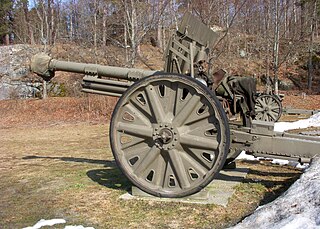
The 10,5 cm Haubits m/40 is a Swedish 105 mm howitzer, which was manufactured by Bofors during World War II.

A director, also called an auxiliary predictor, is a mechanical or electronic computer that continuously calculates trigonometric firing solutions for use against a moving target, and transmits targeting data to direct the weapon firing crew.

The Bofors 57 mm Naval Automatic Gun L/70, among other names, is a series of dual-purpose naval guns designed and produced by the Swedish arms manufacturer AB Bofors, designed in the late 1960s as a replacement design for the twin barreled Bofors 57 mm Naval Automatic Gun L/60. The gun is remotely controlled by a fire-control computer but can as a redundancy measure also be operated manually by crew using instrument panels either on or in direct contact with the gun.

The 37 mm gun M1 was an anti-aircraft autocannon developed in the United States. It was used by the US Army in World War II.

The Landsverk L-60 was a Swedish tank developed in 1934. It was developed by AB Landsverk as a light tank which included several advanced design features such as torsion bar suspension, periscopes rather than view slits and all-welded construction.

The 45 mm anti-aircraft gun (21-K) was a Soviet design adapted from the 45 mm anti-tank gun M1932 (19-K). This was a copy of a 3.7 cm (1.5 in) German weapon designed by Rheinmetall that was sold to the Soviets before Hitler came to power in 1933 that had been enlarged to 45 mm (1.8 in) to reuse a large stock of old 47mm ammunition. It was used by the Soviet Navy to equip almost all of their ships from 1934 as its primary light anti-aircraft gun until replaced by the fully automatic 37 mm 70-K gun from 1942 to 1943. It was used in World War II and during the Cold War as the Soviets exported their World War II-era ships to their friends and allies. However it was not very effective as its slow rate of fire and lack of a time fuze required a direct hit to damage targets.

Bofors 57 mm Naval Automatic Gun L/60, also known as 57 mm/60 (2.25") SAK Model 1950 and the like, was a twin-barreled 57 mm (2.2 in) caliber fully automatic dual purpose naval artillery piece designed by the Swedish arms manufacturer Bofors from the early of the 1940s to the early 1950s to meet a request from the Dutch Navy. Besides the Dutch Navy, the weapon was also adopted by the Swedish and the French Navy, most predominantly by the latter.
The Bofors 57 mm gun is a nickname or designation given to several types of guns designed and developed by the Swedish company Bofors:
The Bofors 120 mm gun is a nickname or designation given to several types of guns designed and developed by the Swedish company Bofors:
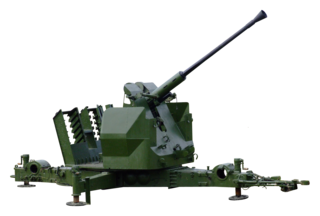
The Bofors 40 mm Automatic Gun L/70,, is a multi-purpose autocannon developed by the Swedish arms manufacturer AB Bofors during the second half of the 1940s as a modern replacement for their extremely successful World War II-era Bofors 40 mm L/60 gun-design. It was initially intended as a dedicated anti-aircraft weapon, being sold as Bofors 40 mm Automatic A.A. Gun L/70, but has since its conception been redeveloped into a dedicated multi-purpose weapon capable of firing both sabot projectiles and programmable ammunition. The Bofors 40 mm L/70 design never achieved the same popularity and historical status as the original L/60 design but has still seen great export and popularity to this day, having been adopted by around 40 different nations and even being accepted as NATO-standard in November 1953. It is still being produced and sold, and several variants exist for both field and naval applications. A notable variant is the Bofors 40/70B "light armored vehicle variant" which is in use on the Swedish Strf 9040 and Korean K21 infantry fighting vehicles.